Impact of National Culture on International HRM: An Analysis
VerifiedAdded on 2023/01/16
|12
|3324
|64
Essay
AI Summary
This essay analyzes the impact of national culture on International Human Resource Management (IHRM), focusing on the practices of Australian firms operating in China. The study employs Hofstede's cultural dimensions theory to compare the cultural attributes of Australia and China, highlighting key differences such as power distance, individualism, masculinity, uncertainty avoidance, long-term orientation, and indulgence. The essay argues that Australian firms must adapt their IHRM strategies to align with Chinese cultural values to achieve success. It emphasizes the importance of integrating local cultural elements into organizational culture and HRM policies, drawing on examples like Walt Disney's experiences in France to illustrate the consequences of failing to do so. The analysis underscores the critical role of national culture in shaping IHRM practices and the need for businesses to navigate cultural nuances effectively in a globalized environment.
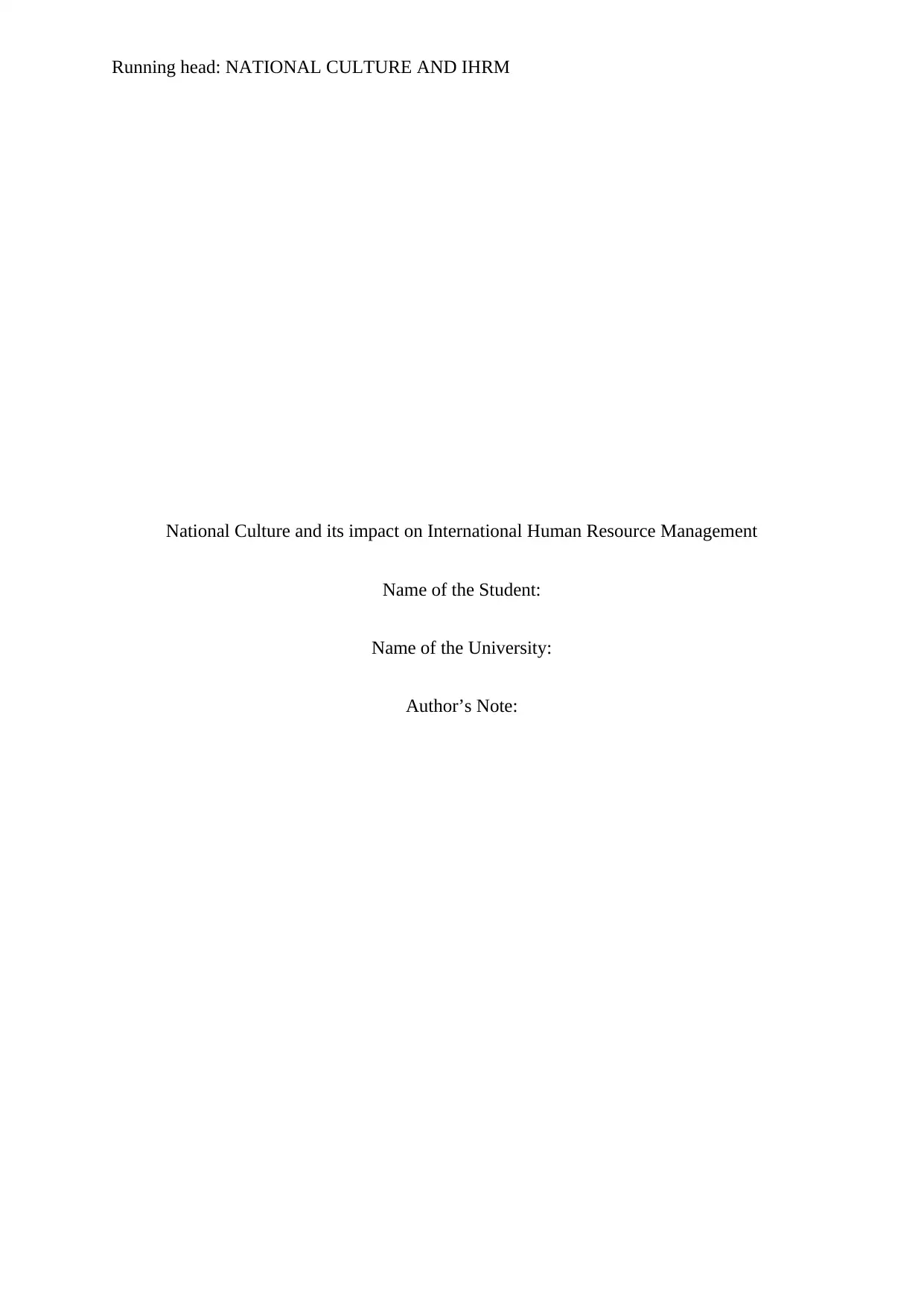
Running head: NATIONAL CULTURE AND IHRM
National Culture and its impact on International Human Resource Management
Name of the Student:
Name of the University:
Author’s Note:
National Culture and its impact on International Human Resource Management
Name of the Student:
Name of the University:
Author’s Note:
Paraphrase This Document
Need a fresh take? Get an instant paraphrase of this document with our AI Paraphraser
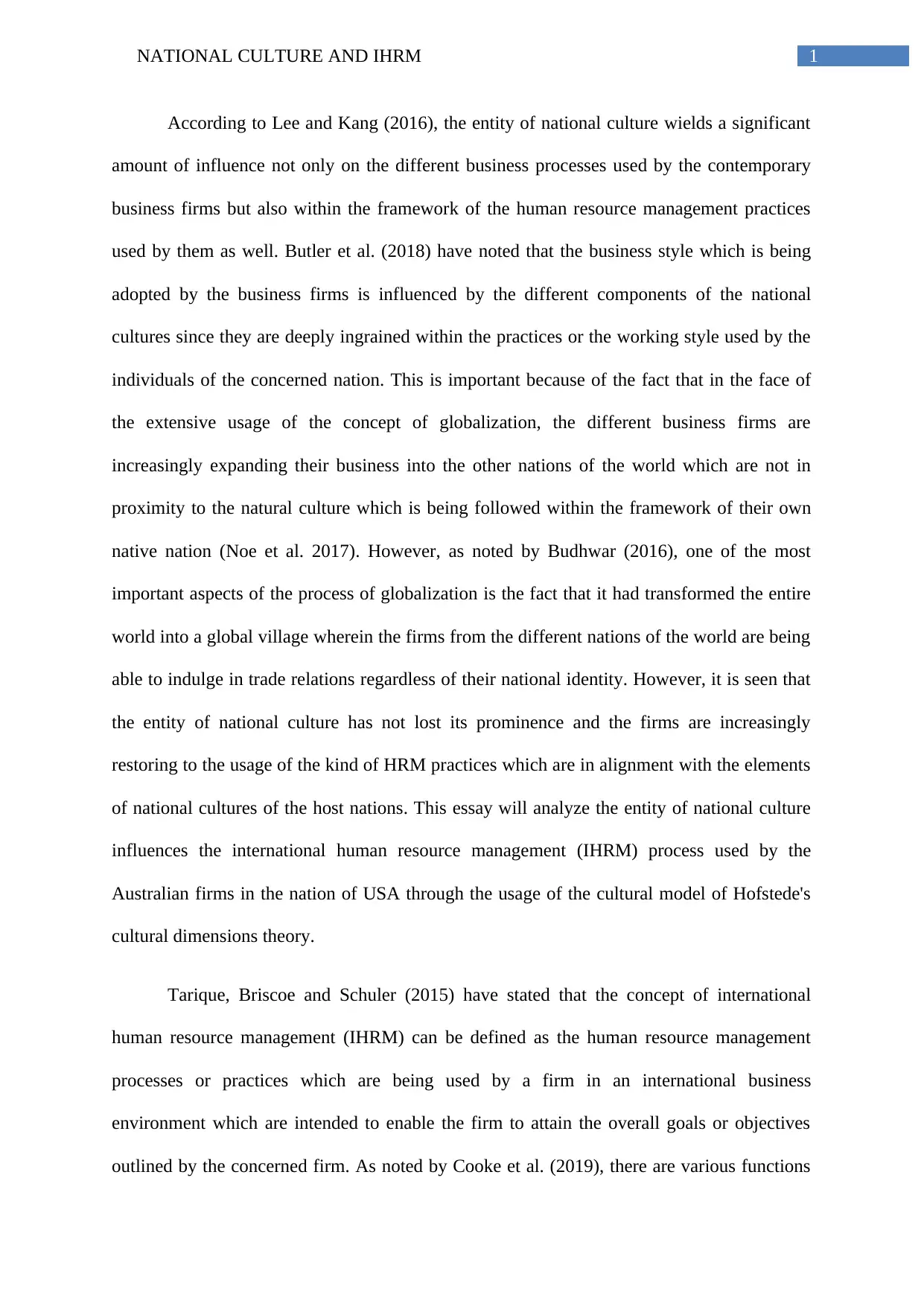
1NATIONAL CULTURE AND IHRM
According to Lee and Kang (2016), the entity of national culture wields a significant
amount of influence not only on the different business processes used by the contemporary
business firms but also within the framework of the human resource management practices
used by them as well. Butler et al. (2018) have noted that the business style which is being
adopted by the business firms is influenced by the different components of the national
cultures since they are deeply ingrained within the practices or the working style used by the
individuals of the concerned nation. This is important because of the fact that in the face of
the extensive usage of the concept of globalization, the different business firms are
increasingly expanding their business into the other nations of the world which are not in
proximity to the natural culture which is being followed within the framework of their own
native nation (Noe et al. 2017). However, as noted by Budhwar (2016), one of the most
important aspects of the process of globalization is the fact that it had transformed the entire
world into a global village wherein the firms from the different nations of the world are being
able to indulge in trade relations regardless of their national identity. However, it is seen that
the entity of national culture has not lost its prominence and the firms are increasingly
restoring to the usage of the kind of HRM practices which are in alignment with the elements
of national cultures of the host nations. This essay will analyze the entity of national culture
influences the international human resource management (IHRM) process used by the
Australian firms in the nation of USA through the usage of the cultural model of Hofstede's
cultural dimensions theory.
Tarique, Briscoe and Schuler (2015) have stated that the concept of international
human resource management (IHRM) can be defined as the human resource management
processes or practices which are being used by a firm in an international business
environment which are intended to enable the firm to attain the overall goals or objectives
outlined by the concerned firm. As noted by Cooke et al. (2019), there are various functions
According to Lee and Kang (2016), the entity of national culture wields a significant
amount of influence not only on the different business processes used by the contemporary
business firms but also within the framework of the human resource management practices
used by them as well. Butler et al. (2018) have noted that the business style which is being
adopted by the business firms is influenced by the different components of the national
cultures since they are deeply ingrained within the practices or the working style used by the
individuals of the concerned nation. This is important because of the fact that in the face of
the extensive usage of the concept of globalization, the different business firms are
increasingly expanding their business into the other nations of the world which are not in
proximity to the natural culture which is being followed within the framework of their own
native nation (Noe et al. 2017). However, as noted by Budhwar (2016), one of the most
important aspects of the process of globalization is the fact that it had transformed the entire
world into a global village wherein the firms from the different nations of the world are being
able to indulge in trade relations regardless of their national identity. However, it is seen that
the entity of national culture has not lost its prominence and the firms are increasingly
restoring to the usage of the kind of HRM practices which are in alignment with the elements
of national cultures of the host nations. This essay will analyze the entity of national culture
influences the international human resource management (IHRM) process used by the
Australian firms in the nation of USA through the usage of the cultural model of Hofstede's
cultural dimensions theory.
Tarique, Briscoe and Schuler (2015) have stated that the concept of international
human resource management (IHRM) can be defined as the human resource management
processes or practices which are being used by a firm in an international business
environment which are intended to enable the firm to attain the overall goals or objectives
outlined by the concerned firm. As noted by Cooke et al. (2019), there are various functions
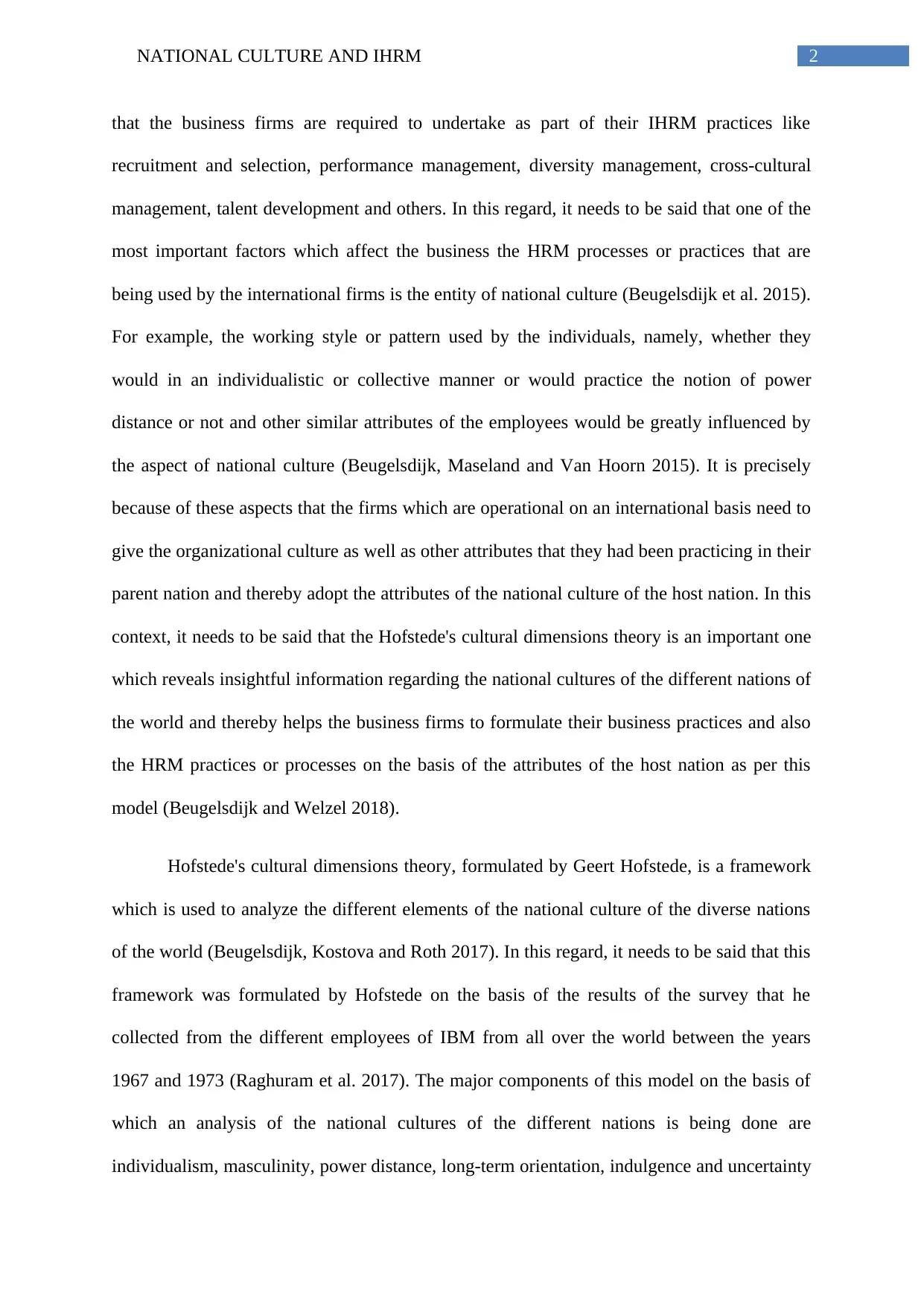
2NATIONAL CULTURE AND IHRM
that the business firms are required to undertake as part of their IHRM practices like
recruitment and selection, performance management, diversity management, cross-cultural
management, talent development and others. In this regard, it needs to be said that one of the
most important factors which affect the business the HRM processes or practices that are
being used by the international firms is the entity of national culture (Beugelsdijk et al. 2015).
For example, the working style or pattern used by the individuals, namely, whether they
would in an individualistic or collective manner or would practice the notion of power
distance or not and other similar attributes of the employees would be greatly influenced by
the aspect of national culture (Beugelsdijk, Maseland and Van Hoorn 2015). It is precisely
because of these aspects that the firms which are operational on an international basis need to
give the organizational culture as well as other attributes that they had been practicing in their
parent nation and thereby adopt the attributes of the national culture of the host nation. In this
context, it needs to be said that the Hofstede's cultural dimensions theory is an important one
which reveals insightful information regarding the national cultures of the different nations of
the world and thereby helps the business firms to formulate their business practices and also
the HRM practices or processes on the basis of the attributes of the host nation as per this
model (Beugelsdijk and Welzel 2018).
Hofstede's cultural dimensions theory, formulated by Geert Hofstede, is a framework
which is used to analyze the different elements of the national culture of the diverse nations
of the world (Beugelsdijk, Kostova and Roth 2017). In this regard, it needs to be said that this
framework was formulated by Hofstede on the basis of the results of the survey that he
collected from the different employees of IBM from all over the world between the years
1967 and 1973 (Raghuram et al. 2017). The major components of this model on the basis of
which an analysis of the national cultures of the different nations is being done are
individualism, masculinity, power distance, long-term orientation, indulgence and uncertainty
that the business firms are required to undertake as part of their IHRM practices like
recruitment and selection, performance management, diversity management, cross-cultural
management, talent development and others. In this regard, it needs to be said that one of the
most important factors which affect the business the HRM processes or practices that are
being used by the international firms is the entity of national culture (Beugelsdijk et al. 2015).
For example, the working style or pattern used by the individuals, namely, whether they
would in an individualistic or collective manner or would practice the notion of power
distance or not and other similar attributes of the employees would be greatly influenced by
the aspect of national culture (Beugelsdijk, Maseland and Van Hoorn 2015). It is precisely
because of these aspects that the firms which are operational on an international basis need to
give the organizational culture as well as other attributes that they had been practicing in their
parent nation and thereby adopt the attributes of the national culture of the host nation. In this
context, it needs to be said that the Hofstede's cultural dimensions theory is an important one
which reveals insightful information regarding the national cultures of the different nations of
the world and thereby helps the business firms to formulate their business practices and also
the HRM practices or processes on the basis of the attributes of the host nation as per this
model (Beugelsdijk and Welzel 2018).
Hofstede's cultural dimensions theory, formulated by Geert Hofstede, is a framework
which is used to analyze the different elements of the national culture of the diverse nations
of the world (Beugelsdijk, Kostova and Roth 2017). In this regard, it needs to be said that this
framework was formulated by Hofstede on the basis of the results of the survey that he
collected from the different employees of IBM from all over the world between the years
1967 and 1973 (Raghuram et al. 2017). The major components of this model on the basis of
which an analysis of the national cultures of the different nations is being done are
individualism, masculinity, power distance, long-term orientation, indulgence and uncertainty
⊘ This is a preview!⊘
Do you want full access?
Subscribe today to unlock all pages.

Trusted by 1+ million students worldwide
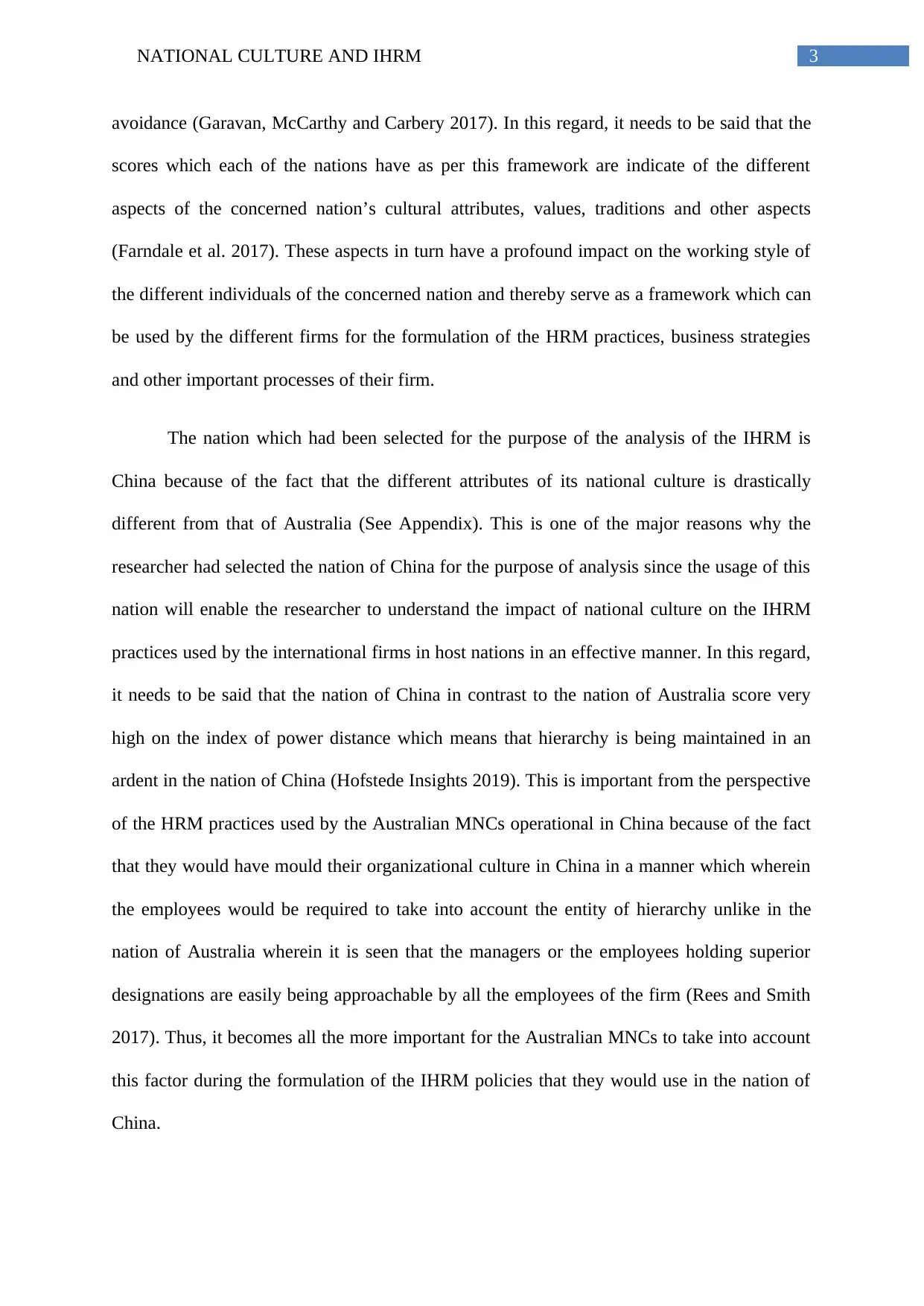
3NATIONAL CULTURE AND IHRM
avoidance (Garavan, McCarthy and Carbery 2017). In this regard, it needs to be said that the
scores which each of the nations have as per this framework are indicate of the different
aspects of the concerned nation’s cultural attributes, values, traditions and other aspects
(Farndale et al. 2017). These aspects in turn have a profound impact on the working style of
the different individuals of the concerned nation and thereby serve as a framework which can
be used by the different firms for the formulation of the HRM practices, business strategies
and other important processes of their firm.
The nation which had been selected for the purpose of the analysis of the IHRM is
China because of the fact that the different attributes of its national culture is drastically
different from that of Australia (See Appendix). This is one of the major reasons why the
researcher had selected the nation of China for the purpose of analysis since the usage of this
nation will enable the researcher to understand the impact of national culture on the IHRM
practices used by the international firms in host nations in an effective manner. In this regard,
it needs to be said that the nation of China in contrast to the nation of Australia score very
high on the index of power distance which means that hierarchy is being maintained in an
ardent in the nation of China (Hofstede Insights 2019). This is important from the perspective
of the HRM practices used by the Australian MNCs operational in China because of the fact
that they would have mould their organizational culture in China in a manner which wherein
the employees would be required to take into account the entity of hierarchy unlike in the
nation of Australia wherein it is seen that the managers or the employees holding superior
designations are easily being approachable by all the employees of the firm (Rees and Smith
2017). Thus, it becomes all the more important for the Australian MNCs to take into account
this factor during the formulation of the IHRM policies that they would use in the nation of
China.
avoidance (Garavan, McCarthy and Carbery 2017). In this regard, it needs to be said that the
scores which each of the nations have as per this framework are indicate of the different
aspects of the concerned nation’s cultural attributes, values, traditions and other aspects
(Farndale et al. 2017). These aspects in turn have a profound impact on the working style of
the different individuals of the concerned nation and thereby serve as a framework which can
be used by the different firms for the formulation of the HRM practices, business strategies
and other important processes of their firm.
The nation which had been selected for the purpose of the analysis of the IHRM is
China because of the fact that the different attributes of its national culture is drastically
different from that of Australia (See Appendix). This is one of the major reasons why the
researcher had selected the nation of China for the purpose of analysis since the usage of this
nation will enable the researcher to understand the impact of national culture on the IHRM
practices used by the international firms in host nations in an effective manner. In this regard,
it needs to be said that the nation of China in contrast to the nation of Australia score very
high on the index of power distance which means that hierarchy is being maintained in an
ardent in the nation of China (Hofstede Insights 2019). This is important from the perspective
of the HRM practices used by the Australian MNCs operational in China because of the fact
that they would have mould their organizational culture in China in a manner which wherein
the employees would be required to take into account the entity of hierarchy unlike in the
nation of Australia wherein it is seen that the managers or the employees holding superior
designations are easily being approachable by all the employees of the firm (Rees and Smith
2017). Thus, it becomes all the more important for the Australian MNCs to take into account
this factor during the formulation of the IHRM policies that they would use in the nation of
China.
Paraphrase This Document
Need a fresh take? Get an instant paraphrase of this document with our AI Paraphraser
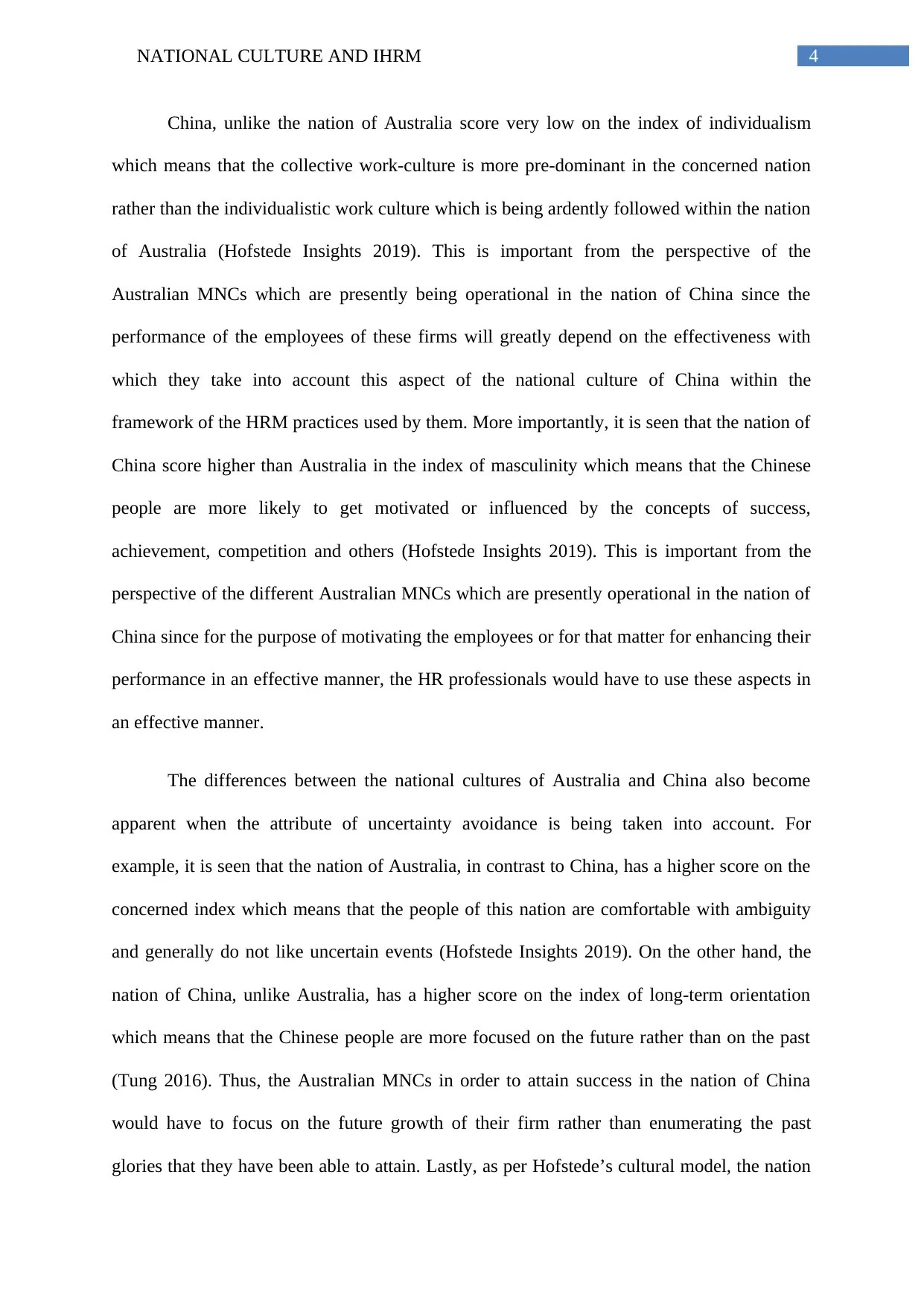
4NATIONAL CULTURE AND IHRM
China, unlike the nation of Australia score very low on the index of individualism
which means that the collective work-culture is more pre-dominant in the concerned nation
rather than the individualistic work culture which is being ardently followed within the nation
of Australia (Hofstede Insights 2019). This is important from the perspective of the
Australian MNCs which are presently being operational in the nation of China since the
performance of the employees of these firms will greatly depend on the effectiveness with
which they take into account this aspect of the national culture of China within the
framework of the HRM practices used by them. More importantly, it is seen that the nation of
China score higher than Australia in the index of masculinity which means that the Chinese
people are more likely to get motivated or influenced by the concepts of success,
achievement, competition and others (Hofstede Insights 2019). This is important from the
perspective of the different Australian MNCs which are presently operational in the nation of
China since for the purpose of motivating the employees or for that matter for enhancing their
performance in an effective manner, the HR professionals would have to use these aspects in
an effective manner.
The differences between the national cultures of Australia and China also become
apparent when the attribute of uncertainty avoidance is being taken into account. For
example, it is seen that the nation of Australia, in contrast to China, has a higher score on the
concerned index which means that the people of this nation are comfortable with ambiguity
and generally do not like uncertain events (Hofstede Insights 2019). On the other hand, the
nation of China, unlike Australia, has a higher score on the index of long-term orientation
which means that the Chinese people are more focused on the future rather than on the past
(Tung 2016). Thus, the Australian MNCs in order to attain success in the nation of China
would have to focus on the future growth of their firm rather than enumerating the past
glories that they have been able to attain. Lastly, as per Hofstede’s cultural model, the nation
China, unlike the nation of Australia score very low on the index of individualism
which means that the collective work-culture is more pre-dominant in the concerned nation
rather than the individualistic work culture which is being ardently followed within the nation
of Australia (Hofstede Insights 2019). This is important from the perspective of the
Australian MNCs which are presently being operational in the nation of China since the
performance of the employees of these firms will greatly depend on the effectiveness with
which they take into account this aspect of the national culture of China within the
framework of the HRM practices used by them. More importantly, it is seen that the nation of
China score higher than Australia in the index of masculinity which means that the Chinese
people are more likely to get motivated or influenced by the concepts of success,
achievement, competition and others (Hofstede Insights 2019). This is important from the
perspective of the different Australian MNCs which are presently operational in the nation of
China since for the purpose of motivating the employees or for that matter for enhancing their
performance in an effective manner, the HR professionals would have to use these aspects in
an effective manner.
The differences between the national cultures of Australia and China also become
apparent when the attribute of uncertainty avoidance is being taken into account. For
example, it is seen that the nation of Australia, in contrast to China, has a higher score on the
concerned index which means that the people of this nation are comfortable with ambiguity
and generally do not like uncertain events (Hofstede Insights 2019). On the other hand, the
nation of China, unlike Australia, has a higher score on the index of long-term orientation
which means that the Chinese people are more focused on the future rather than on the past
(Tung 2016). Thus, the Australian MNCs in order to attain success in the nation of China
would have to focus on the future growth of their firm rather than enumerating the past
glories that they have been able to attain. Lastly, as per Hofstede’s cultural model, the nation
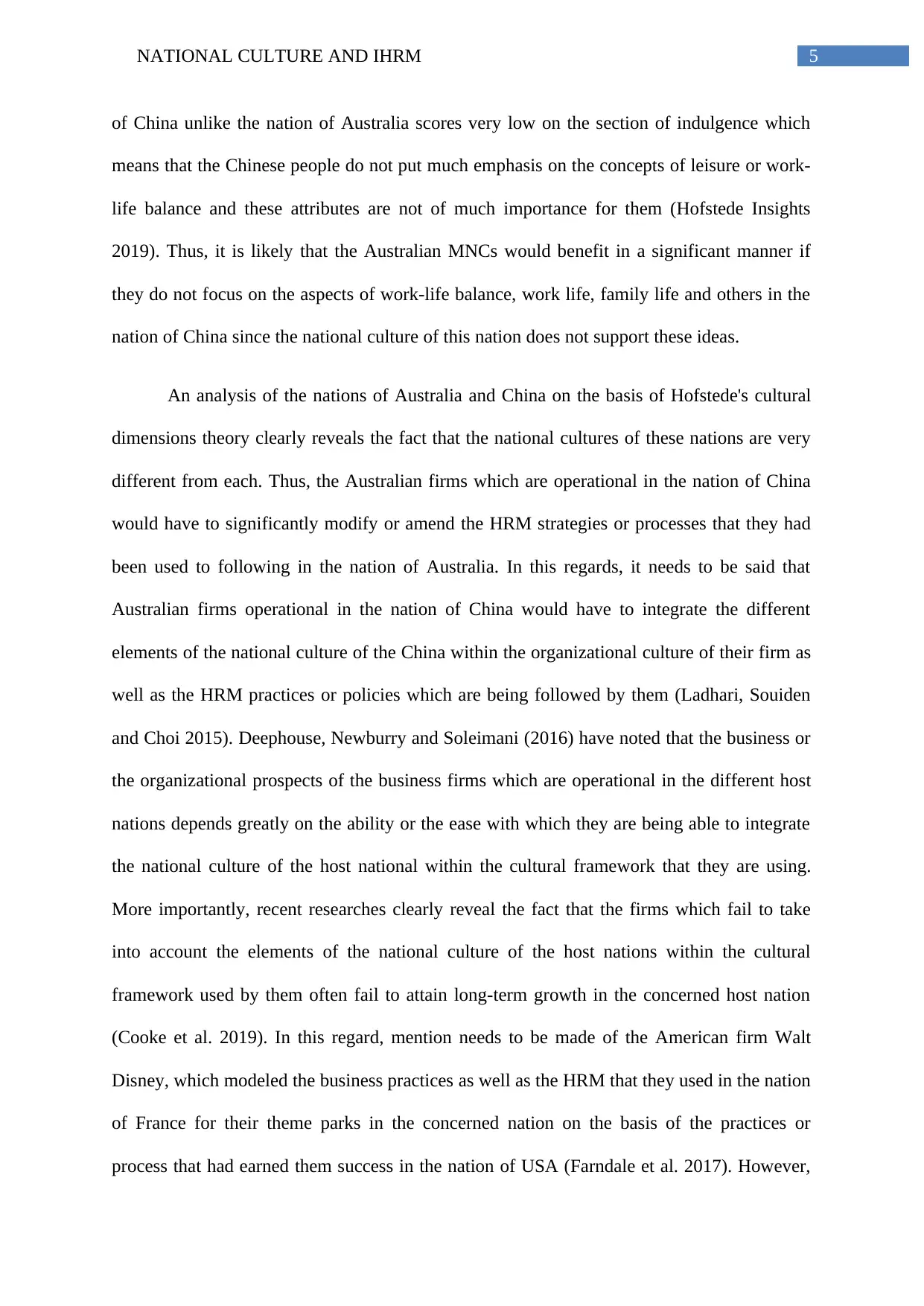
5NATIONAL CULTURE AND IHRM
of China unlike the nation of Australia scores very low on the section of indulgence which
means that the Chinese people do not put much emphasis on the concepts of leisure or work-
life balance and these attributes are not of much importance for them (Hofstede Insights
2019). Thus, it is likely that the Australian MNCs would benefit in a significant manner if
they do not focus on the aspects of work-life balance, work life, family life and others in the
nation of China since the national culture of this nation does not support these ideas.
An analysis of the nations of Australia and China on the basis of Hofstede's cultural
dimensions theory clearly reveals the fact that the national cultures of these nations are very
different from each. Thus, the Australian firms which are operational in the nation of China
would have to significantly modify or amend the HRM strategies or processes that they had
been used to following in the nation of Australia. In this regards, it needs to be said that
Australian firms operational in the nation of China would have to integrate the different
elements of the national culture of the China within the organizational culture of their firm as
well as the HRM practices or policies which are being followed by them (Ladhari, Souiden
and Choi 2015). Deephouse, Newburry and Soleimani (2016) have noted that the business or
the organizational prospects of the business firms which are operational in the different host
nations depends greatly on the ability or the ease with which they are being able to integrate
the national culture of the host national within the cultural framework that they are using.
More importantly, recent researches clearly reveal the fact that the firms which fail to take
into account the elements of the national culture of the host nations within the cultural
framework used by them often fail to attain long-term growth in the concerned host nation
(Cooke et al. 2019). In this regard, mention needs to be made of the American firm Walt
Disney, which modeled the business practices as well as the HRM that they used in the nation
of France for their theme parks in the concerned nation on the basis of the practices or
process that had earned them success in the nation of USA (Farndale et al. 2017). However,
of China unlike the nation of Australia scores very low on the section of indulgence which
means that the Chinese people do not put much emphasis on the concepts of leisure or work-
life balance and these attributes are not of much importance for them (Hofstede Insights
2019). Thus, it is likely that the Australian MNCs would benefit in a significant manner if
they do not focus on the aspects of work-life balance, work life, family life and others in the
nation of China since the national culture of this nation does not support these ideas.
An analysis of the nations of Australia and China on the basis of Hofstede's cultural
dimensions theory clearly reveals the fact that the national cultures of these nations are very
different from each. Thus, the Australian firms which are operational in the nation of China
would have to significantly modify or amend the HRM strategies or processes that they had
been used to following in the nation of Australia. In this regards, it needs to be said that
Australian firms operational in the nation of China would have to integrate the different
elements of the national culture of the China within the organizational culture of their firm as
well as the HRM practices or policies which are being followed by them (Ladhari, Souiden
and Choi 2015). Deephouse, Newburry and Soleimani (2016) have noted that the business or
the organizational prospects of the business firms which are operational in the different host
nations depends greatly on the ability or the ease with which they are being able to integrate
the national culture of the host national within the cultural framework that they are using.
More importantly, recent researches clearly reveal the fact that the firms which fail to take
into account the elements of the national culture of the host nations within the cultural
framework used by them often fail to attain long-term growth in the concerned host nation
(Cooke et al. 2019). In this regard, mention needs to be made of the American firm Walt
Disney, which modeled the business practices as well as the HRM that they used in the nation
of France for their theme parks in the concerned nation on the basis of the practices or
process that had earned them success in the nation of USA (Farndale et al. 2017). However,
⊘ This is a preview!⊘
Do you want full access?
Subscribe today to unlock all pages.

Trusted by 1+ million students worldwide
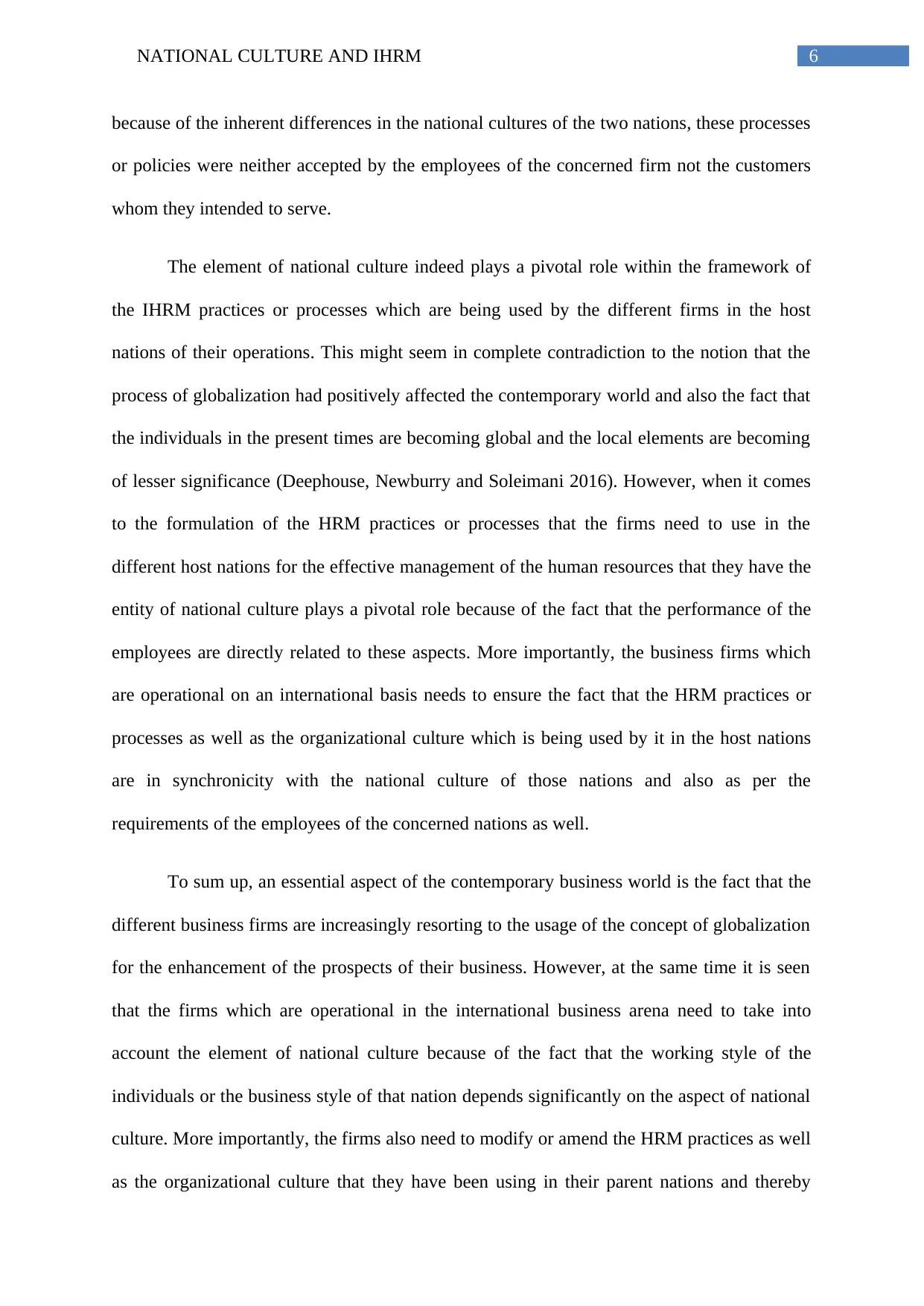
6NATIONAL CULTURE AND IHRM
because of the inherent differences in the national cultures of the two nations, these processes
or policies were neither accepted by the employees of the concerned firm not the customers
whom they intended to serve.
The element of national culture indeed plays a pivotal role within the framework of
the IHRM practices or processes which are being used by the different firms in the host
nations of their operations. This might seem in complete contradiction to the notion that the
process of globalization had positively affected the contemporary world and also the fact that
the individuals in the present times are becoming global and the local elements are becoming
of lesser significance (Deephouse, Newburry and Soleimani 2016). However, when it comes
to the formulation of the HRM practices or processes that the firms need to use in the
different host nations for the effective management of the human resources that they have the
entity of national culture plays a pivotal role because of the fact that the performance of the
employees are directly related to these aspects. More importantly, the business firms which
are operational on an international basis needs to ensure the fact that the HRM practices or
processes as well as the organizational culture which is being used by it in the host nations
are in synchronicity with the national culture of those nations and also as per the
requirements of the employees of the concerned nations as well.
To sum up, an essential aspect of the contemporary business world is the fact that the
different business firms are increasingly resorting to the usage of the concept of globalization
for the enhancement of the prospects of their business. However, at the same time it is seen
that the firms which are operational in the international business arena need to take into
account the element of national culture because of the fact that the working style of the
individuals or the business style of that nation depends significantly on the aspect of national
culture. More importantly, the firms also need to modify or amend the HRM practices as well
as the organizational culture that they have been using in their parent nations and thereby
because of the inherent differences in the national cultures of the two nations, these processes
or policies were neither accepted by the employees of the concerned firm not the customers
whom they intended to serve.
The element of national culture indeed plays a pivotal role within the framework of
the IHRM practices or processes which are being used by the different firms in the host
nations of their operations. This might seem in complete contradiction to the notion that the
process of globalization had positively affected the contemporary world and also the fact that
the individuals in the present times are becoming global and the local elements are becoming
of lesser significance (Deephouse, Newburry and Soleimani 2016). However, when it comes
to the formulation of the HRM practices or processes that the firms need to use in the
different host nations for the effective management of the human resources that they have the
entity of national culture plays a pivotal role because of the fact that the performance of the
employees are directly related to these aspects. More importantly, the business firms which
are operational on an international basis needs to ensure the fact that the HRM practices or
processes as well as the organizational culture which is being used by it in the host nations
are in synchronicity with the national culture of those nations and also as per the
requirements of the employees of the concerned nations as well.
To sum up, an essential aspect of the contemporary business world is the fact that the
different business firms are increasingly resorting to the usage of the concept of globalization
for the enhancement of the prospects of their business. However, at the same time it is seen
that the firms which are operational in the international business arena need to take into
account the element of national culture because of the fact that the working style of the
individuals or the business style of that nation depends significantly on the aspect of national
culture. More importantly, the firms also need to modify or amend the HRM practices as well
as the organizational culture that they have been using in their parent nations and thereby
Paraphrase This Document
Need a fresh take? Get an instant paraphrase of this document with our AI Paraphraser
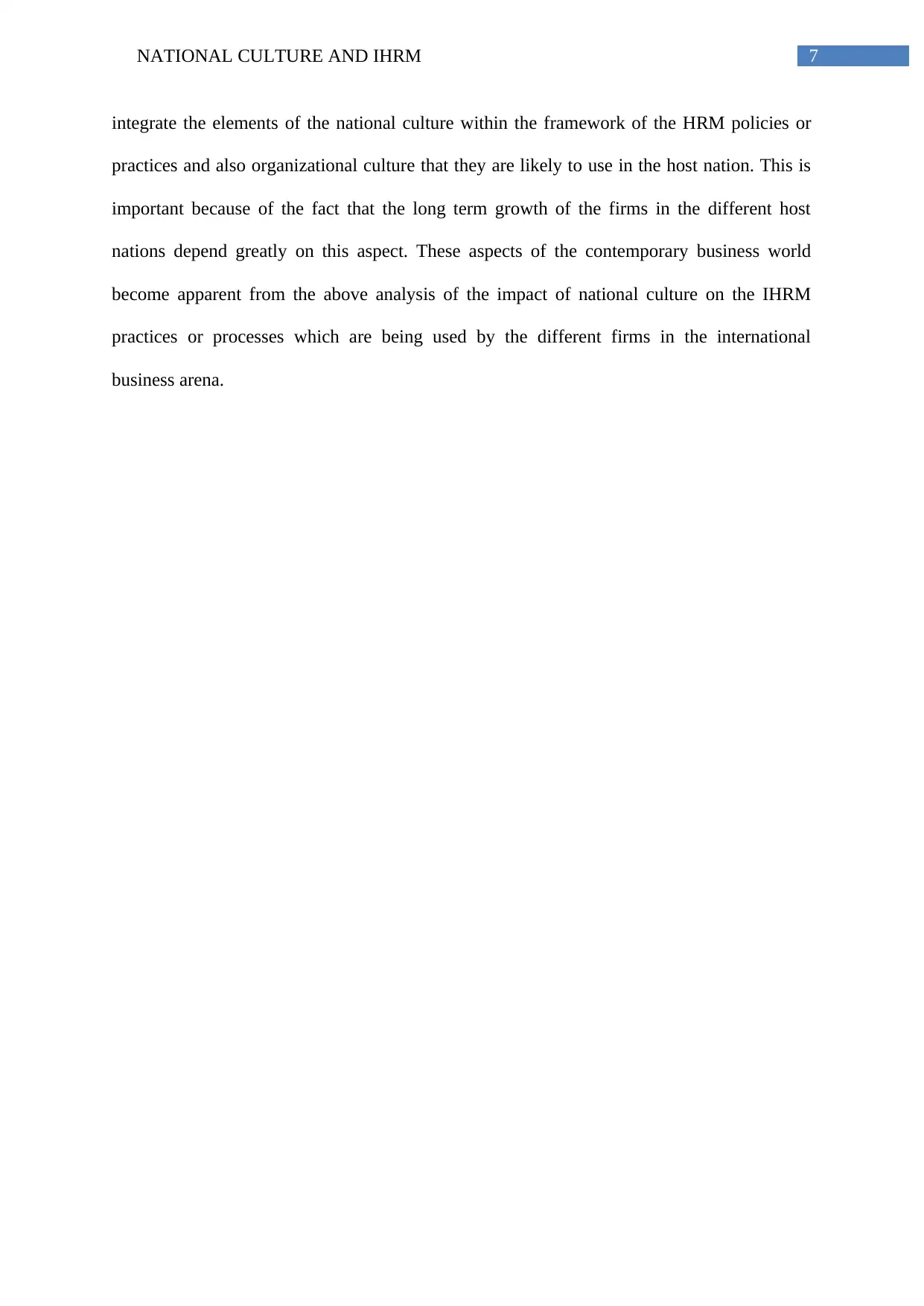
7NATIONAL CULTURE AND IHRM
integrate the elements of the national culture within the framework of the HRM policies or
practices and also organizational culture that they are likely to use in the host nation. This is
important because of the fact that the long term growth of the firms in the different host
nations depend greatly on this aspect. These aspects of the contemporary business world
become apparent from the above analysis of the impact of national culture on the IHRM
practices or processes which are being used by the different firms in the international
business arena.
integrate the elements of the national culture within the framework of the HRM policies or
practices and also organizational culture that they are likely to use in the host nation. This is
important because of the fact that the long term growth of the firms in the different host
nations depend greatly on this aspect. These aspects of the contemporary business world
become apparent from the above analysis of the impact of national culture on the IHRM
practices or processes which are being used by the different firms in the international
business arena.
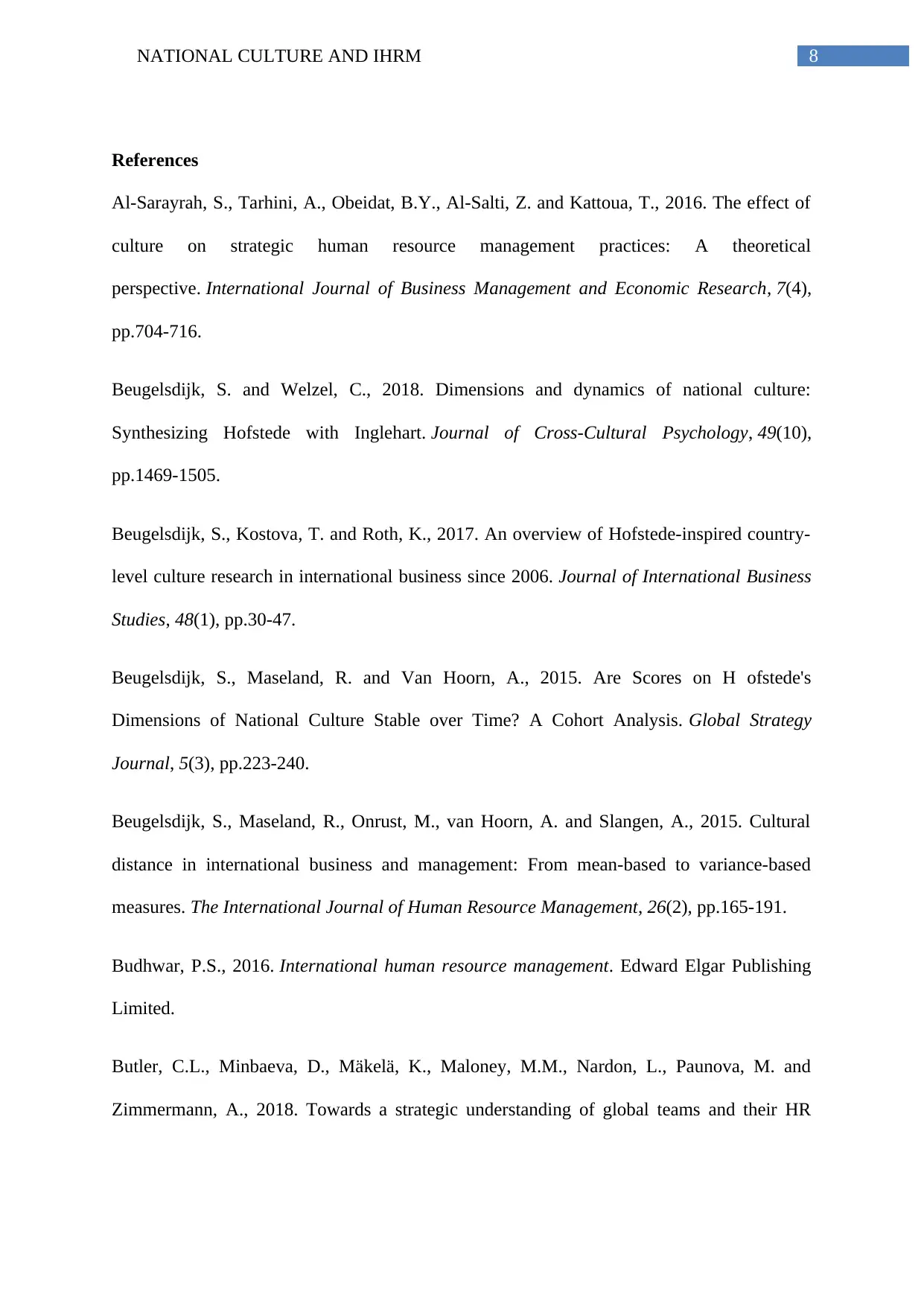
8NATIONAL CULTURE AND IHRM
References
Al-Sarayrah, S., Tarhini, A., Obeidat, B.Y., Al-Salti, Z. and Kattoua, T., 2016. The effect of
culture on strategic human resource management practices: A theoretical
perspective. International Journal of Business Management and Economic Research, 7(4),
pp.704-716.
Beugelsdijk, S. and Welzel, C., 2018. Dimensions and dynamics of national culture:
Synthesizing Hofstede with Inglehart. Journal of Cross-Cultural Psychology, 49(10),
pp.1469-1505.
Beugelsdijk, S., Kostova, T. and Roth, K., 2017. An overview of Hofstede-inspired country-
level culture research in international business since 2006. Journal of International Business
Studies, 48(1), pp.30-47.
Beugelsdijk, S., Maseland, R. and Van Hoorn, A., 2015. Are Scores on H ofstede's
Dimensions of National Culture Stable over Time? A Cohort Analysis. Global Strategy
Journal, 5(3), pp.223-240.
Beugelsdijk, S., Maseland, R., Onrust, M., van Hoorn, A. and Slangen, A., 2015. Cultural
distance in international business and management: From mean-based to variance-based
measures. The International Journal of Human Resource Management, 26(2), pp.165-191.
Budhwar, P.S., 2016. International human resource management. Edward Elgar Publishing
Limited.
Butler, C.L., Minbaeva, D., Mäkelä, K., Maloney, M.M., Nardon, L., Paunova, M. and
Zimmermann, A., 2018. Towards a strategic understanding of global teams and their HR
References
Al-Sarayrah, S., Tarhini, A., Obeidat, B.Y., Al-Salti, Z. and Kattoua, T., 2016. The effect of
culture on strategic human resource management practices: A theoretical
perspective. International Journal of Business Management and Economic Research, 7(4),
pp.704-716.
Beugelsdijk, S. and Welzel, C., 2018. Dimensions and dynamics of national culture:
Synthesizing Hofstede with Inglehart. Journal of Cross-Cultural Psychology, 49(10),
pp.1469-1505.
Beugelsdijk, S., Kostova, T. and Roth, K., 2017. An overview of Hofstede-inspired country-
level culture research in international business since 2006. Journal of International Business
Studies, 48(1), pp.30-47.
Beugelsdijk, S., Maseland, R. and Van Hoorn, A., 2015. Are Scores on H ofstede's
Dimensions of National Culture Stable over Time? A Cohort Analysis. Global Strategy
Journal, 5(3), pp.223-240.
Beugelsdijk, S., Maseland, R., Onrust, M., van Hoorn, A. and Slangen, A., 2015. Cultural
distance in international business and management: From mean-based to variance-based
measures. The International Journal of Human Resource Management, 26(2), pp.165-191.
Budhwar, P.S., 2016. International human resource management. Edward Elgar Publishing
Limited.
Butler, C.L., Minbaeva, D., Mäkelä, K., Maloney, M.M., Nardon, L., Paunova, M. and
Zimmermann, A., 2018. Towards a strategic understanding of global teams and their HR
⊘ This is a preview!⊘
Do you want full access?
Subscribe today to unlock all pages.

Trusted by 1+ million students worldwide
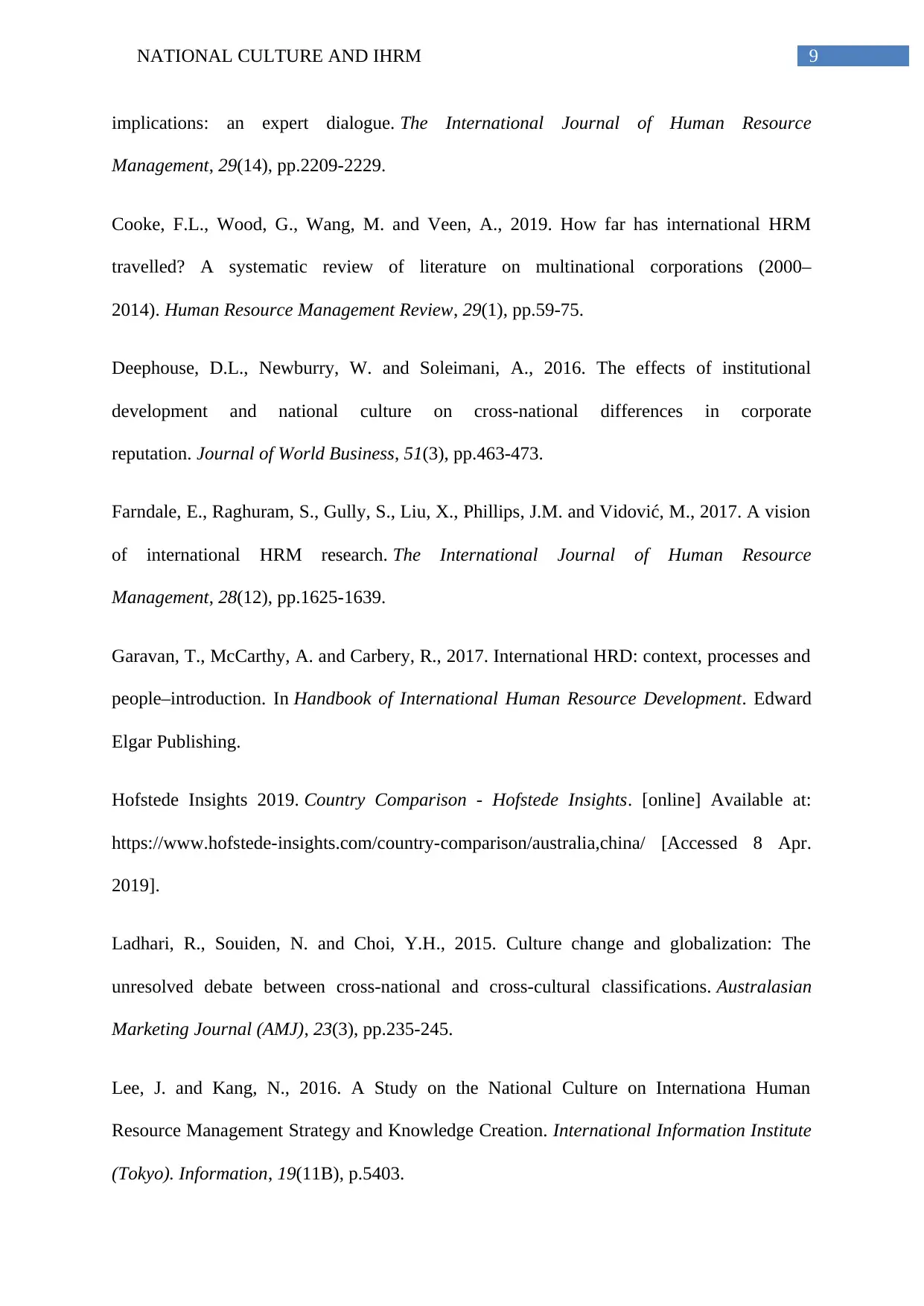
9NATIONAL CULTURE AND IHRM
implications: an expert dialogue. The International Journal of Human Resource
Management, 29(14), pp.2209-2229.
Cooke, F.L., Wood, G., Wang, M. and Veen, A., 2019. How far has international HRM
travelled? A systematic review of literature on multinational corporations (2000–
2014). Human Resource Management Review, 29(1), pp.59-75.
Deephouse, D.L., Newburry, W. and Soleimani, A., 2016. The effects of institutional
development and national culture on cross-national differences in corporate
reputation. Journal of World Business, 51(3), pp.463-473.
Farndale, E., Raghuram, S., Gully, S., Liu, X., Phillips, J.M. and Vidović, M., 2017. A vision
of international HRM research. The International Journal of Human Resource
Management, 28(12), pp.1625-1639.
Garavan, T., McCarthy, A. and Carbery, R., 2017. International HRD: context, processes and
people–introduction. In Handbook of International Human Resource Development. Edward
Elgar Publishing.
Hofstede Insights 2019. Country Comparison - Hofstede Insights. [online] Available at:
https://www.hofstede-insights.com/country-comparison/australia,china/ [Accessed 8 Apr.
2019].
Ladhari, R., Souiden, N. and Choi, Y.H., 2015. Culture change and globalization: The
unresolved debate between cross-national and cross-cultural classifications. Australasian
Marketing Journal (AMJ), 23(3), pp.235-245.
Lee, J. and Kang, N., 2016. A Study on the National Culture on Internationa Human
Resource Management Strategy and Knowledge Creation. International Information Institute
(Tokyo). Information, 19(11B), p.5403.
implications: an expert dialogue. The International Journal of Human Resource
Management, 29(14), pp.2209-2229.
Cooke, F.L., Wood, G., Wang, M. and Veen, A., 2019. How far has international HRM
travelled? A systematic review of literature on multinational corporations (2000–
2014). Human Resource Management Review, 29(1), pp.59-75.
Deephouse, D.L., Newburry, W. and Soleimani, A., 2016. The effects of institutional
development and national culture on cross-national differences in corporate
reputation. Journal of World Business, 51(3), pp.463-473.
Farndale, E., Raghuram, S., Gully, S., Liu, X., Phillips, J.M. and Vidović, M., 2017. A vision
of international HRM research. The International Journal of Human Resource
Management, 28(12), pp.1625-1639.
Garavan, T., McCarthy, A. and Carbery, R., 2017. International HRD: context, processes and
people–introduction. In Handbook of International Human Resource Development. Edward
Elgar Publishing.
Hofstede Insights 2019. Country Comparison - Hofstede Insights. [online] Available at:
https://www.hofstede-insights.com/country-comparison/australia,china/ [Accessed 8 Apr.
2019].
Ladhari, R., Souiden, N. and Choi, Y.H., 2015. Culture change and globalization: The
unresolved debate between cross-national and cross-cultural classifications. Australasian
Marketing Journal (AMJ), 23(3), pp.235-245.
Lee, J. and Kang, N., 2016. A Study on the National Culture on Internationa Human
Resource Management Strategy and Knowledge Creation. International Information Institute
(Tokyo). Information, 19(11B), p.5403.
Paraphrase This Document
Need a fresh take? Get an instant paraphrase of this document with our AI Paraphraser
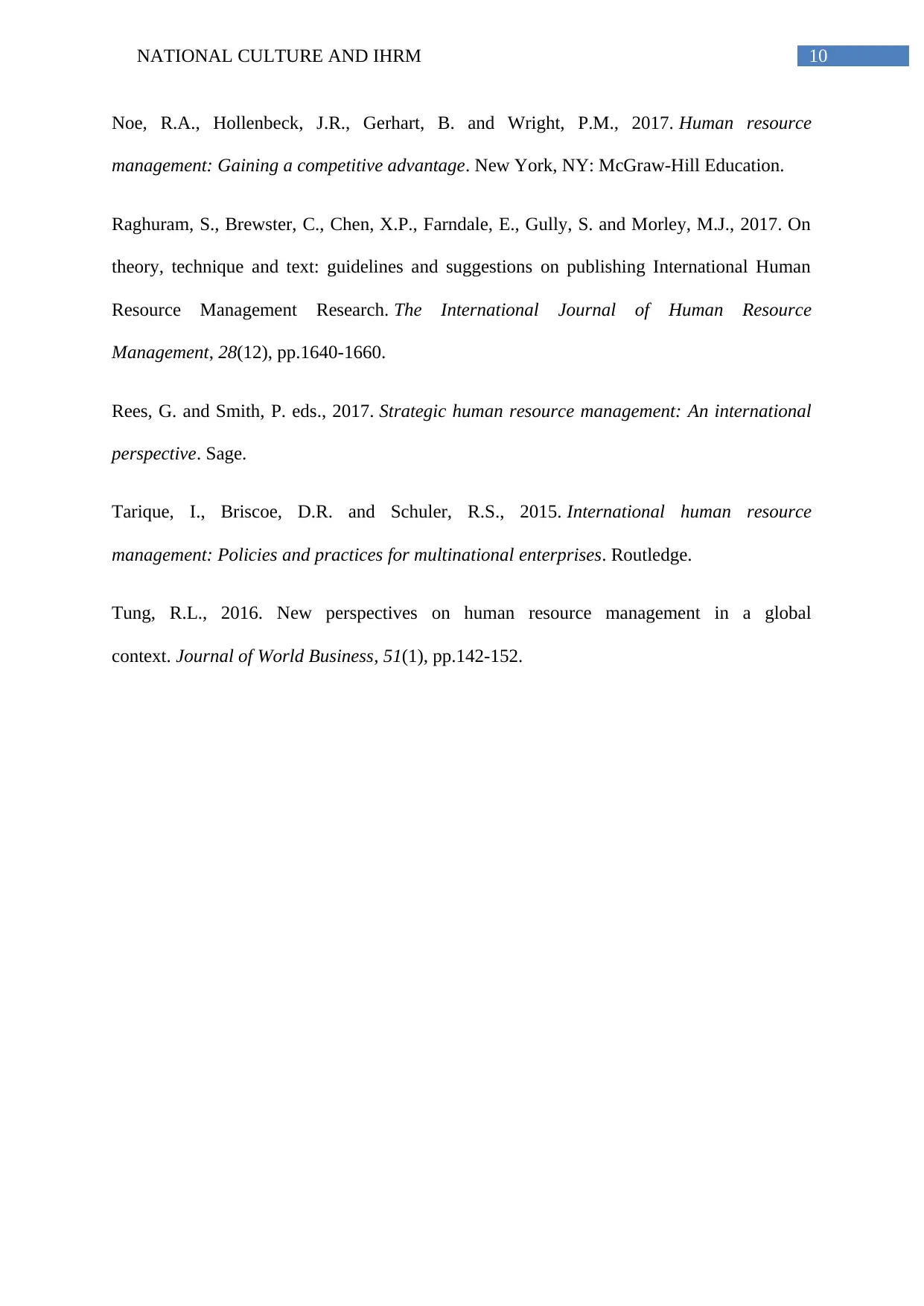
10NATIONAL CULTURE AND IHRM
Noe, R.A., Hollenbeck, J.R., Gerhart, B. and Wright, P.M., 2017. Human resource
management: Gaining a competitive advantage. New York, NY: McGraw-Hill Education.
Raghuram, S., Brewster, C., Chen, X.P., Farndale, E., Gully, S. and Morley, M.J., 2017. On
theory, technique and text: guidelines and suggestions on publishing International Human
Resource Management Research. The International Journal of Human Resource
Management, 28(12), pp.1640-1660.
Rees, G. and Smith, P. eds., 2017. Strategic human resource management: An international
perspective. Sage.
Tarique, I., Briscoe, D.R. and Schuler, R.S., 2015. International human resource
management: Policies and practices for multinational enterprises. Routledge.
Tung, R.L., 2016. New perspectives on human resource management in a global
context. Journal of World Business, 51(1), pp.142-152.
Noe, R.A., Hollenbeck, J.R., Gerhart, B. and Wright, P.M., 2017. Human resource
management: Gaining a competitive advantage. New York, NY: McGraw-Hill Education.
Raghuram, S., Brewster, C., Chen, X.P., Farndale, E., Gully, S. and Morley, M.J., 2017. On
theory, technique and text: guidelines and suggestions on publishing International Human
Resource Management Research. The International Journal of Human Resource
Management, 28(12), pp.1640-1660.
Rees, G. and Smith, P. eds., 2017. Strategic human resource management: An international
perspective. Sage.
Tarique, I., Briscoe, D.R. and Schuler, R.S., 2015. International human resource
management: Policies and practices for multinational enterprises. Routledge.
Tung, R.L., 2016. New perspectives on human resource management in a global
context. Journal of World Business, 51(1), pp.142-152.
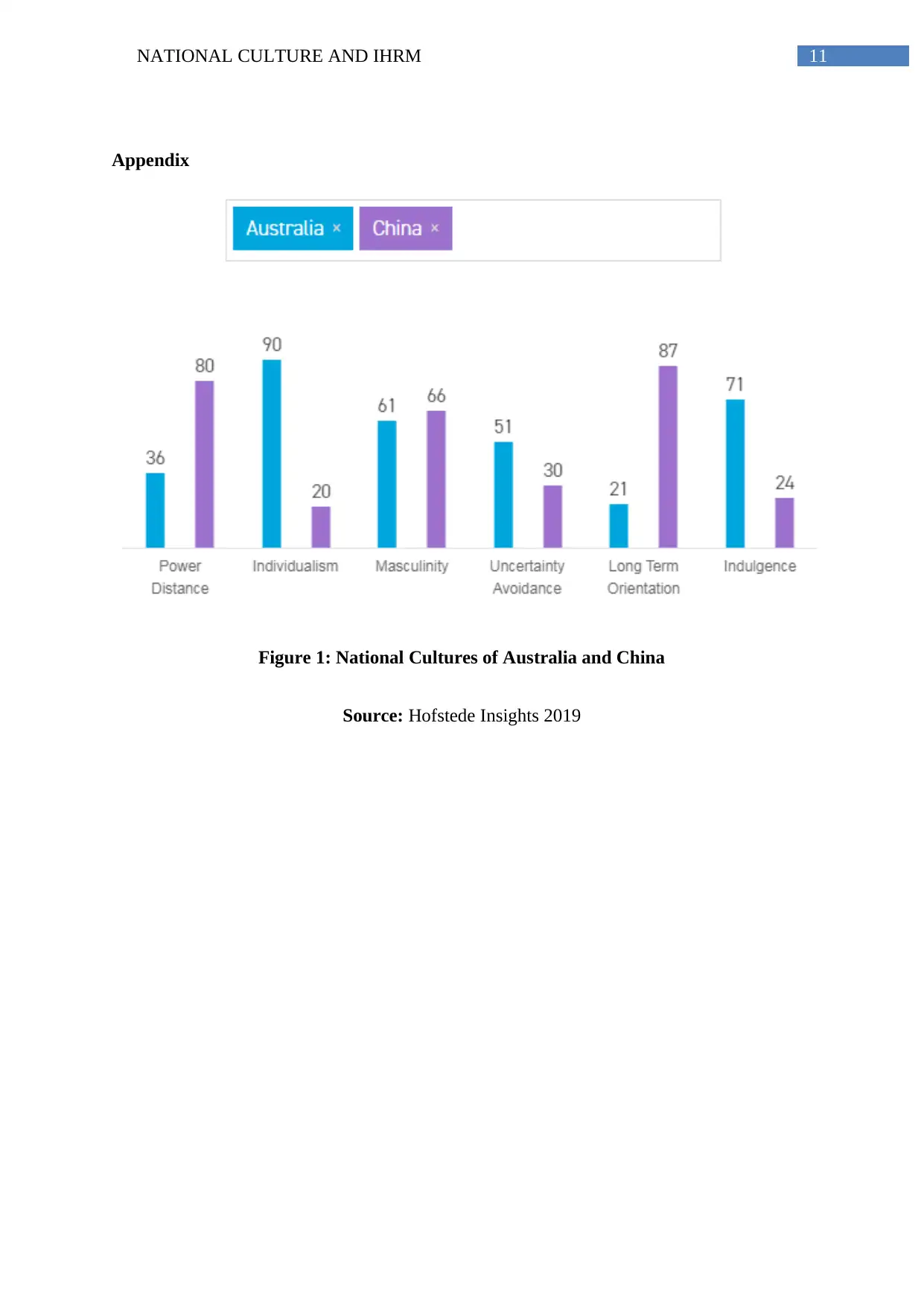
11NATIONAL CULTURE AND IHRM
Appendix
Figure 1: National Cultures of Australia and China
Source: Hofstede Insights 2019
Appendix
Figure 1: National Cultures of Australia and China
Source: Hofstede Insights 2019
⊘ This is a preview!⊘
Do you want full access?
Subscribe today to unlock all pages.

Trusted by 1+ million students worldwide
1 out of 12
Related Documents
Your All-in-One AI-Powered Toolkit for Academic Success.
+13062052269
info@desklib.com
Available 24*7 on WhatsApp / Email
![[object Object]](/_next/static/media/star-bottom.7253800d.svg)
Unlock your academic potential
Copyright © 2020–2025 A2Z Services. All Rights Reserved. Developed and managed by ZUCOL.




